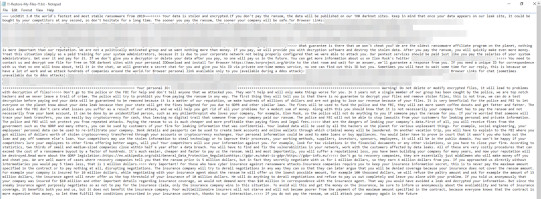Ransom.Win64.LOCKBIT.C
Trojan.Win64.Krypt (IKARUS),
Windows


Threat Type: Ransomware
Destructiveness: No
Encrypted: Yes
In the wild: Yes
OVERVIEW
Downloaded from the Internet, Dropped by other malware
This Ransomware drops files as ransom note. It avoids encrypting files with the following file extensions.
TECHNICAL DETAILS
251,392 bytes
EXE
No
29 Mar 2023
Encrypts files, Displays message/message boxes
Installation
This Ransomware adds the following processes:
- cmd.exe /c C:WindowsSystem32wbemWMIC.exe shadowcopy where "ID='%s'" delete → used to delete shadow copies
It adds the following mutexes to ensure that only one of its copies runs at any one time:
- Mutex Name: hsfjuukjzloqu28oajh727190
Other Details
This Ransomware does the following:
- It also encrypts database related file extensions:
- .4dd
- .4dl
- .accdb
- .accdc
- .accde
- .accdr
- .accdt
- .accft
- .adb
- .ade
- .adf
- .adp
- .arc
- .ora
- .alf
- .ask
- .btr
- .bdf
- .cat
- .cdb
- .ckp
- .cma
- .cpd
- .dacpac
- .dad
- .dadiagrams
- .daschema
- .db
- .db-shm
- .db-wal
- .db3
- .dbc
- .dbf
- .dbs
- .dbt
- .dbv
- .dbx
- .dcb
- .dct
- .dcx
- .ddl
- .dlis
- .dp1
- .dqy
- .dsk
- .dsn
- .dtsx
- .dxl
- .eco
- .ecx
- .edb
- .epim
- .exb
- .fcd
- .fdb
- .fic
- .fmp
- .fmp12
- .fmps1
- .fol
- .fp3
- .fp4
- .fp5
- .fp7
- .fpt
- .frm
- .gdb
- grbd
- .gwi
- .hdb
- .his
- .ib
- .idb
- .ihx
- .itdb
- .itw
- .kexi
- .kexic
- .kexis
- .lwx
- .jet
- .jtx
- .lgc
- .kdb
- .maf
- .maq
- .mar
- .mas
- .mav
- .mdb
- .mdf
- .mpd
- .mrg
- .mud
- .mwb
- .myd
- .ndf
- .nnt
- .nrmlib
- .ns2
- .ns3
- .ns4
- .nsf
- .nv
- .nv2
- .nwdb
- .nyf
- .odb
- .oqy
- .orx
- .owc
- .p96
- .p97
- .pan
- .pdb
- .pdm
- .pnz
- .qry
- .qvd
- .rbf
- .rctd
- .rod
- .rodx
- .rpd
- .rsd
- .sbf
- .scx
- .sdb
- .sdc
- .sas7bdat
- .sbf
- .scx
- .sis
- .spq
- .sdb
- .sdc
- .sdf
- .sql
- .sqlite
- .sqlite3
- .sqlitedb
- .te
- .temx
- .tmd
- .tps
- .trc
- .trm
- .udb
- .udl
- .usr
- .v12
- .vis
- .vpd
- .vvv
- .wdb
- .wmdb
- .wrk
- .xdb
- .xmlff
- .abcddb
- .xld
- .abs
- .abx
- .accdw
- .adn
- .db2
- .fm5
- .hjt
- .icg
- .icr
- .kdb
- .lut
- .maw
- .mdn
- .mdt
- It also encrypts disk image related files extensions:
- .vdi
- .vhd
- .pvm
- .vmx
- .raw
- .bin
- .vsv
- .iso
- .vmdk
- .vmem
- .vmsn
- .vmsd
- .avhd
- .vmrs
- .vhdx
- .avdx
- .vmcx
- .nvram
- .qcow2
- .subvol
- Checking if the network share starts with the IP address:
- 172.
- 192.168.
- 10.
- 169.
It accepts the following parameters:
- -log {file name} – create log output base on the file name that you enter to parameter
- -size – {chunk mode}
- -nomutex – it doesn’t create mutex
- -m - delete all backups and encrypt all
- -p - encrypt specific folder first before proceeding to other folders
- -m -{local|net|backups}
- local - delete backups and encrypt local drives
- net - delete backups and encrypt network shares
- backups - delete backups
Ransomware Routine
This Ransomware avoids encrypting files with the following strings in their file name:
- CONTI_LOG.txt
- !!!-Restore-My-Files-!!!.txt
It avoids encrypting files with the following strings in their file path:
- tmp
- winnt
- temp
- thumb
- $Recycle.Bin
- $RECYCLE.BIN
- System Volume Information
- Boot
- Windows
- Trend Micro
- perflogs
It appends the following extension to the file name of the encrypted files:
- .6b226bbd
It drops the following file(s) as ransom note:
- {Encrypted Directory}\!!!-Restore-My-Files-!!!.txt

It avoids encrypting files with the following file extensions:
- .6b226bbd
- .exe
- .dll
- .lnk
- .sys
- .msi
- .bat
SOLUTION
9.800
18.350.02
29 Mar 2023
18.351.00
30 Mar 2023
Step 1
Trend Micro Predictive Machine Learning detects and blocks malware at the first sign of its existence, before it executes on your system. When enabled, your Trend Micro product detects this malware under the following machine learning name:
- Ransom.Win32.TRX.XXPE50FFF067
Step 2
Before doing any scans, Windows 7, Windows 8, Windows 8.1, and Windows 10 users must disable System Restore to allow full scanning of their computers.
Step 3
Note that not all files, folders, and registry keys and entries are installed on your computer during this malware's/spyware's/grayware's execution. This may be due to incomplete installation or other operating system conditions. If you do not find the same files/folders/registry information, please proceed to the next step.
Step 4
Search and delete these files
- {Encrypted Directory}\!!!-Restore-My-Files-!!!.txt
Step 5
Scan your computer with your Trend Micro product to delete files detected as Ransom.Win64.LOCKBIT.C. If the detected files have already been cleaned, deleted, or quarantined by your Trend Micro product, no further step is required. You may opt to simply delete the quarantined files. Please check the following Trend Micro Support pages for more information:
Step 6
Restore encrypted files from backup.
Did this description help? Tell us how we did.

